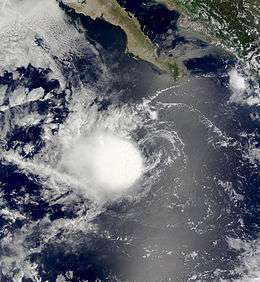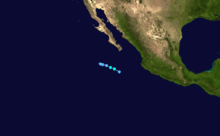Tropical Storm Karina (2008)
| Tropical storm (SSHWS/NWS) | |
 Tropical Storm Karina at peak intensity | |
| Formed | September 2, 2008 |
|---|---|
| Dissipated | September 3, 2008 |
| Highest winds |
1-minute sustained: 40 mph (65 km/h) |
| Lowest pressure | 1000 mbar (hPa); 29.53 inHg |
| Fatalities | None reported |
| Damage | None |
| Areas affected | Socorro Island |
| Part of the 2008 Pacific hurricane season | |
Tropical Storm Karina was a weak, short-lived tropical cyclone that developed during the 2008 Pacific hurricane season. The 12th tropical cyclone and 11th named storm of the season, it originated out of a tropical wave in the North Atlantic hurricane basin. The wave entered the Pacific Ocean on August 30 and spawned an area of low pressure off the western coast of Mexico on the morning of September 1. The low had become sufficiently organized to be declared a tropical depression the next morning. The depression quickly developed into a tropical storm later in the morning, at which time it was named Karina and reached its peak intensity of 40 miles per hour (65 km/h) with a minimum pressure of 1000 mbar (hPa; 29.54 inHg). Later that day, after being classified a tropical storm for 12 hours, wind shear weakened the storm to a depression on September 3 and it dissipated shortly thereafter.
Meteorological history

Tropical Storm Karina originated from the southern portion of the tropical wave—a tropical wave is an elongated low pressure area embedded within the easterly trade winds—that also spawned Hurricane Gustav in the Caribbean Sea. The wave crossed Central America and entered the eastern Pacific basin on August 28.[1] After two days, the wave spawned an area of low pressure south of Manzanillo, Mexico.[1] The low was located beneath an area of moderate convection, but was nearing cooler waters and a moist, yet stable, air mass.[2] By later that night, a low-level circulation developed partially underneath deep thunderstorm activity. In an area favorable for development, a tropical cyclone formation alert was issued on September 2.[3] However, strong easterly shear separated the showers and thunderstorms from the center of circulation. Despite the shear, sufficient convection developed around the center; the National Hurricane Center (NHC) classified it a tropical depression at 0600 UTC, while centered about 390 miles (630 km) south of the southern tip of Baja California.[1] The NHC initially did not recognize the system as a tropical depression and did not initiate advisories[4] on it until several hours later.[5] The depression quickly intensified into a tropical storm due to a brief relaxation of the wind shear and was given the name Karina while located about 25 mi (40 km) north of Socorro Island.[1]
Karina was located to the south of a weakening mid-level ridge, leading to a relatively slow west-northwest movement at 9 mph (15 km/h).[5] Upon becoming a tropical storm, Karina reached its peak with winds of 40 mph (65 km/h). There was uncertainty as to the intensity of the storm, as the Dvorak technique—a system used to estimate the intensity of a tropical cyclone—rendered an intensity of 50 mph (80 km/h); but because the center of the storm had just moved under the deep convection, the winds were held at minimal tropical storm intensity.[6] That night, 12 hours after being declared a tropical storm, Karina was downgraded to a tropical depression.[7] Strong easterly wind shear of at least 25 mph (40 km/h) tore away the deep convection that previously surrounded Karina.[8] Karina was moving into a stable environment over cooling waters which would prevent convection from redeveloping, despite a forecast of lessening wind shear. The forward motion gradually decreased.[7] By the morning of September 3, convection had been sheared 125 mi (200 km) from the center of circulation, leaving only a swirl of clouds.[9] Karina degenerated into a remnant low-pressure area later that morning and the NHC issued their final advisory.[10] The remnant low quickly dissipated that afternoon.[1]
Preparations and impact

When the National Hurricane Center issued its first advisory on Karina, the storm was near the island of Socorro.[11] There were no known preparations taken before the storm, as the island is mainly a natural reserve and the only inhabitants reside in a military base.[12] On Clarion Island, residents took minor actions to prepare for possible impact from the storm. Officials advised residents to cancel all coastal activities and comply with advice from the National Civil Protection. Small crafts were advised to exercise extreme caution.[13] In Cabo San Lucas, officials closed the port due to high waves produced by Karina; small crafts such as water taxis and jet skis were to remain at the port.[14] Port officials in Oaxaca and Chiapas advised boaters of strong winds, rain, and low visibility that they may encounter when nearing the seas around Karina.[15] Despite the proximity to Socorro, no damage was reported and Karina remained far enough away from Clarion that there was no impact on the island. There were no ship reports of tropical storm-force winds.[1]
See also
- 2008 Pacific hurricane season
- Other East Pacific tropical storms
- Timeline of the 2008 Pacific hurricane season
References
- 1 2 3 4 5 6 Lixion A. Avila (2008). "Tropical Storm Karina Tropical Cyclone Report" (PDF). National Hurricane Center. Retrieved 2008-10-20.
- ↑ Wally Barnes (2008). "Tropical Weather Discussion 1605 UTC September 1, 2008". National Hurricane Center. Retrieved 2008-10-05.
- ↑ "Tropical Cyclone Formation Alert September 2, 2008". Joint Typhoon Warning Center. 2008. Archived from the original on September 2, 2008. Retrieved 2008-11-15.
- ↑ The National Hurricane Center publishes advisories on active tropical cyclones to inform the public about possible impact from them
- 1 2 Franklin (2008). "Tropical Storm Karina Public Advisory One". National Hurricane Center. Retrieved 2008-10-05.
- ↑ Franklin (2008). "Tropical Depression Karina Discussion One". National Hurricane Center. Retrieved 2008-10-05.
- 1 2 Blake (2008). "Tropical Depression Karina Discussion Three". National Hurricane Center. Retrieved 2008-10-05.
- ↑ Kimberlain (2008). "Tropical Weather Discussion 0405 UTC September 3, 2008". National Hurricane Center. Retrieved 2008-10-05.
- ↑ Roberts/Pasch (2008). "Tropical Depression Karina Discussion Four". National Hurricane Center. Retrieved 2008-10-05.
- ↑ Rhome (2008). "Remnant Low Karina Discussion Five". National Hurricane Center. Retrieved 2008-10-05.
- ↑ Franklin (2008). "Tropical Storm Karina Wind Speed Probability Advisory One". National Hurricane Center. Retrieved 2008-11-15.
- ↑ Associated Press (2008). "Se forma tormenta tropical Karina en el Pacífico" (in Spanish). El Universo. Retrieved 2008-11-15.
- ↑ Manuel Muñoz; Blanca Ortega & Marco A. (2008). "Zona Costera de Máxima Atención Por Efectos de Tormenta Tropical" (in Spanish). Sistema da Alerta Temprana. Retrieved 2008-11-15.
- ↑ Verónica González Soto (2008-08-03). "Monitorean avance de Karina" (in Spanish). El Sudcaliforniano. Retrieved 2008-12-23.
- ↑ Rodolfo Hernández González (2008-08-02). "Recomiendan tomar medidas a la navegación en las costas de Chiapas" (in Spanish). Noticias Huixtla. Retrieved 2008-12-23.
External links
| Wikimedia Commons has media related to Tropical Storm Karina (2008). |
- The NHC's Tropical Cyclone Report on Tropical Storm Karina.
- The NHC's archive on Tropical Storm Karina.
- The NHC's Tropical Cyclone Outlook for the Eastern Pacific.
